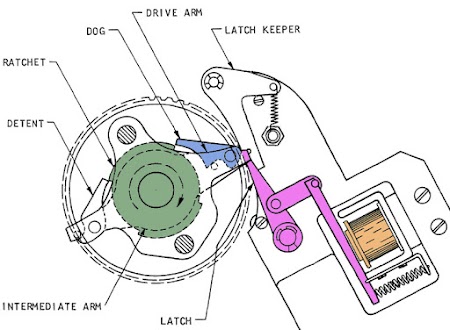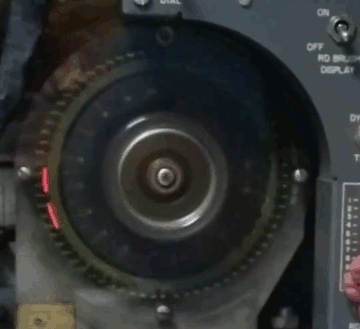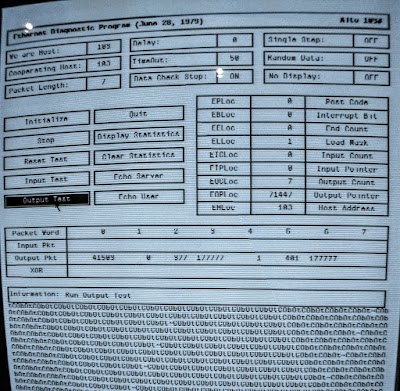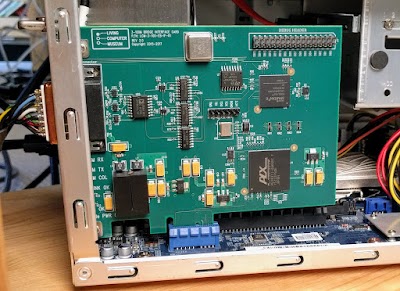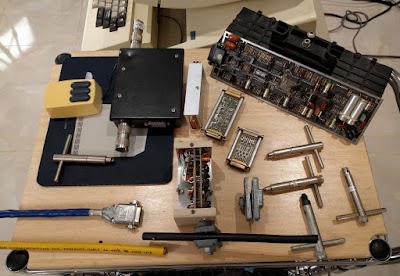The IBM 1401 was a popular business computer of the early 1960s, used for applications such as payroll or inventory. Data records were stored on 80-column punch cards, which were read into the computer by the card reader and printed on the high-speed line printer. The IBM 1401's card reader (above) could read 800 cards per minute—over 13 cards per second—which is a remarkable speed for a mechanical device. Cards whizzed through the card reader, 80 metal brushes read the holes in each column, and then the cards were stacked in the hoppers in the middle of the reader.3 If anything went wrong, from a misread card to a card jam, the card reader would slam to a halt (hopefully before bent cards started piling up) and an error light would illuminate on the card reader's control panel. At this point, the operator would fix the problem and processing could continue.2
The photo below shows the IBM card reader/punch with the front doors opened up. The right half is the reader and the left half is the punch. (The punch records data on cards; I will ignore it in this article.) The blue panel has the operator controls and indicators. Cards enter through the feeder in the upper right, travel right-to-left through the brushes (behind the blue panel) and fall into the stacker slots (center). To the right of the stacker is the service panel with the dynamic timer (circle with knob); this will be relevant later. The relays, resistors, capacitors and diodes that make up the reader's circuitry are below the service panel. Converting the hole pattern to characters was done by the 1401 computer, not the reader, so this circuitry is fairly basic.3 The garbage can on the lower left collects "chips", the bits punched out of cards by the punch, and triggers a warning light when it is full.
A few months ago a problem with the card reader kept showing up under certain circumstances: the card reader would halt with a "Reader Stop" error, indicating a problem with card feeding and travel.2 Given the age of the card reader at the Computer History Museum, it's not surprising that Reader Stop problems arise. However, in this case, cards were feeding fine and there was nothing visibly wrong. Eventually the 1401 maintenance team determined that the problem occurred if you do multiple cycles of reading a card, printing a line on the printer, reading a card, printing a line, and so on. The first three cards read fine, but the fourth card read always failed with a Reader Stop. But during normal processing, hundreds of cards could be read without a problem. What was different about repeatedly reading and printing?
The card reader can read 800 cards per minute, but the line printer can only print 600 lines per minute. Thus, if you continuously read and print, the printer will eventually fall behind. The consequence is that the card reader will occasionally be blocked while the printer finishes a line. In particular, the system can read and print three cards in a row, but there is a delay before reading the fourth card.4 This is normal behavior for the system, but for some reason, this delay was triggering the Reader Stop error.
The question at this point of the investigation was why the delayed read triggered a Reader Stop. The logic diagram below shows the many different things can cause a Reader Stop.5 (This logic was implemented in the reader by relay circuits of Byzantine complexity.) Usually a card jam or card feed problem is responsible for a stop, but there weren't any card movement problem. And the card levers (microswitches) that detect card movement were operating correctly. Eventually, the team discovered that removing relay R-10 (Read Clutch Impulse near the bottom of the diagram) stopped the Reader Check from happening. Removing this relay prevented the clutch status from being checked8 so it prevented the error from being reported but didn't fix the underlying problems. It did, however, indicate that the problem was with the clutch.
At this point, I'll explain how the clutch works in the card reader. The card reader is powered by a 1/4 horsepower electric motor. This motor powers a variety of shafts, belts, rollers and cams inside the card reader. However, the reader needs a mechanism to rapidly start and stop card reading under computer control. This is accomplished by a clutch that powers the card feed rollers. With the clutch engaged, cards will be fed through the card reader. With the clutch disengaged, cards will not move (although other parts of the reader will keep running). The GIF below shows the clutch in action: it is disengaged for one cycle and engaged for one cycle. Although the silver pulley (driven by the motor) turns continuously, the black gear is started and stopped by the clutch, which is just behind the black gear.
The diagram below shows the main parts of the clutch. The ratchet (green) continuously rotates, powered by the motor. When the coil (orange) pulls the latch (purple), the dog (blue) will fall into the ratchet (green), engaging the clutch. This will cause the outer wheel to rotate in sync with the ratchet, feeding a card. After one cycle, the clutch can be disengaged by the latch, or can remain clutched for another cycle. Above, you can see the latch move just before the clutch engages. The dogs and ratchet are hidden behind the black gear. For more details, see the footnotes.67
The clutch requires careful timing. If the coil pulls the latch too late, the dog won't engage with the ratchet until the next cycle and no card will be fed. And if the latch is released too late, the clutch won't disengage until the next cycle, feeding an extra card. Either way, this would cause a serious problem if you are, for instance, printing payroll checks. To catch this, the card reader includes a clutch check circuit that ensures that a clutch happens only when requested.8 This circuit is what triggered the Reader Stop issue.
Timing in the card reader is controlled by the angular position of the main drive shaft; there isn't a clock signal. A 360° rotation of the drive shaft corresponds to one card read cycle.9 The mechanical and electrical components must be precisely adjusted so they activate at the correct rotational angles. For instance, a card's first row of holes reaches the brushes at 8° and card lever #1 is triggered at 227°. And the clutch is engaged or disengaged at exactly 315°. Electrical signals are generated by rotating cams that open and close microswitches at the appropriate degree angles. For example the read clutch is controlled by cam RC6 that closes at 272° and opens at 342°. The photo below shows a cam on a drive shaft, with the microswitch above it; when the cam rotates to a high point, the switch closes.
To examine timings, the card reader has an interesting maintenance feature called the Dynamic Timer, which is sort of a mechanical oscilloscope that visually shows the angle timing of signals. The dynamic timer consists of a neon bulb that spins behind a plastic disk labeled with the angles from 0° to 359°. If a signal is selected with a control panel switch, the bulb lights up when the signal is active.1 Because the neon bulb is spun by the main driveshaft, its position is synchronized to the rotation angle of the card reader's mechanisms. Thus, the neon bulb traces out sectors of a circle, indicating when the signal is active. For example, the image below shows the read brush signal, which is activated as each card row passes under the brushes. Since there are 12 rows on a punch card, the signal is activated 12 times in a card cycle. By reading the angle labels on the clear plastic dial, the signal timings can be checked for correctness. In addition, the knob in the middle of the dynamic timer can be rotated manually to move the card reader's cycle to any desired angle.
We measured the timing of read clutch control cam RC6 and found it was off by about 5 degrees. The manual called the timing of this cam "critical" saying it needed to be within 2° earlier or 0° later from the correct angle.10 Since the cam was well outside the allowed range, we tried to adjust it. The first problem was that the cam was frozen to the shaft; apparently after decades of storage in a a damp garage it had rusted to the shaft. Carl eventually hit the cam hard enough (yet carefully!) with a hammer to loosen it from the shaft so it could be adjusted.
The photo below shows how we manually adjusted cam timings. The dynamic timing wheel (left) can be turned by hand until the cam closes, and then the angle can be read from the dial. The adjustment process is rather tedious, requiring trial and error. First, the duration that contact is closed is corrected by moving the contact closer or farther from the cam. After each adjustment, the duration must be manually checked by slowly rotating the dynamic timing wheel 360°. Once the duration is correct, the next step is to rotate the cam a few degrees at a time until it closes and opens at the right angle. Again, the timing must be carefully checked after each adjustment until trial-and-error yields the right cam setting.
Once cam RC6 had the proper timing, we tested the card reader. Surprisingly, it failed just as before. We checked the timing of RC6 with the dynamic timer, and strangely, the timer still showed that it closed 5° too late, even though we had measured it as closing correctly. After puzzling over the schematics, I found that cam RC6 was powered through cam RL10, so a bad timing on cam RL10 would cause the dynamic timer to show the wrong time for RC6.
We continued the next week and measurement of RL10 showed it was closing 5° too late. So we repeated the cam adjustment process with RL10. Carl loosened RL10's setscrews, whacked it with a hammer, and was surprised when it spun around on the shaft—apparently it hadn't rusted onto the shaft the way RC6 had. Since the timing of RL10 was now thoroughly off, it took some extra effort to find the right position for it. One complication is that RL cams only rotate while the clutch is tripped, so we had to manually trip the clutch for each test. (This video shows how the clutch can be tripped manually.) After a couple hours of adjustment, the cam had the right duration and then the right start angle.
We powered up the card reader and this time it ran all the tests successfully! We had found the elusive problem. Apparently cam RL10 was open a bit too much, so the signal to read a card after a pause in reading wasn't quite able to engage the clutch. Then the clutch check circuitry would detect that the clutch had failed to engage, triggering the Read Stop.
Conclusion
Tracking down and fixing the mysterious Reader Stop errors on the card reader was tricky and more time-consuming than most problems. But it provided an interesting look back in time at the obsolete technology used inside the card reader: relay logic, spinning cams and a mechanical clutch. Debugging the card reader is a different experience from tracking down software problems or even normal hardware problems. Just understanding the schematics with their obsolete symbols can be a challenge. Hopefully what we learned in this repair will help us the next time the card reader malfunctions.
Many members of the 1401 restoration team were involved in fixing this problem, including Carl, Frank, Alexy, Ron, George, Glenn, Jim and Grant. The Computer History Museum in Mountain View runs demonstrations of the IBM 1401 on Wednesdays and Saturdays so check it out if you're in the area; the demo schedule is here.
Follow me on Twitter or RSS to find out about my latest blog posts.
Notes and references
-
While IBM's computers were supposed to be transistorized by the time of the 1401, two vacuum tubes are hidden deep inside the card reader. These tubes power the neon bulbs for the dynamic timer used for diagnostics. The photo below shows the tubes and the transformer that powers them.
The 1402 card reader contains two vacuum tubes to drive the neon bulbs in the dynamic timer. -
The 1402 card reader reports three types of errors. A Reader Stop indicates a jam or card feed problem. (This is the error we encountered.) A Validity error indicates an invalid character caused by a bad hole pattern. A Reader Check indicates that the card was read incorrectly. An interesting technique was used to detect a bad read. The first set of brushes was used to count the number of holes in each column. The second set of brushes performed the actual read of the characters. If the number of holes in a column was different between the first and second reads, the system knew that the card had been read incorrectly. (This was typically caused by a brush that was slightly out of alignment or making bad contact.) You might wonder why the holes were counted, instead of just checking the characters. Counting holes required fewer bits of expensive core memory. ↩
-
The card reader itself didn't convert the hole pattern into characters. Instead, there were 80 parallel wires directly from the 80 hole-sensing brushes to the computer, which did the hole-to-character conversion. The reader had one set of brushes to count holes (for the error check) and a second set to actually read the characters. The punch had a set of brushes to check the punched holes and optionally a set of brushes to read before punching. Thus, there could be up to four sets of brushes in the reader/punch. In addition, the punch had 80 wires from the computer to the 80 hole punch coils. As a result, two massive 200-wire cables connected the card reader and the computer. ↩
-
The 1401 computer has a core-memory print buffer that allows computation to continue while printing a line. However, a complex interlock circuit will block the computer if it tries to print a line while the buffer is still in use. (This buffering and locking is all done in hardware; there is no operating system.) The print buffer was an optional feature for the computer, renting for an extra $386 per month. ↩
-
The Reader Stop diagram shown earlier is somewhat confusing, but I'll give an overview. As cards pass through the card reader, they trip microswitches (called Card Levers or CLC). The logic tests if a microswitch isn't triggered, indicating if a card got jammed before reaching the microswitch. For example, the second triangle triggers an error if there are cards in the hopper, but no card reached card lever 1 after a feed signal. (Note that the logic symbols are backwards compared to modern usage; IBM used a semicircle for OR, and a triangle for AND. Thus, each set of inputs into a triangle shows a set of conditions that will trigger a reader stop.)
A label like R-6 indicates that the signal comes from relay 6. Relay R-13 is the Reader Stop Control relay; it gets triggered if there was a card at microswitch 1 or 2 during angle 158°-188°. During this time, the card should have already passed the microswitch, so if it is still closed, there must be a jam. "CLC 1 DELAY" indicates that there was a card at CLC 1 in the previous cycle. If there is no card at CLC 2 this cycle, the card must have been jammed along the way. ↩
-
Several documents on the 1402 card reader/punch are available on bitsavers. The IBM 1402 Card Read-Punch Manual is an operator's manual for the card reader. The Customer Engineering Manual of Instruction explains the implementation of the card reader for the service engineer, and is probably the best guide to how it operates. The Customer Engineering Instruction Reference Manual explains the internals of the card reader, with a focus on maintenance. The Wiring Diagram provides schematics of the card reader. The Service Index provides a summary of information for servicing. ↩
-
The operation of the clutch mechanism is a bit tricky. In the diagram below, the ratchet (green) is constantly spinning. The remaining parts of the clutch are connected together and rotate only when the clutch is engaged. The key idea is that when the intermediate arm (middle) is latched, the control studs push the dogs up and out of the ratchet disengaging the clutch. (This happens because the intermediate arm can pivot slightly relative to the drive arm (left), so the dog pivot and control stud will move relative to each other, swinging the dogs upwards.) When the intermediate arm is unlatched, the dogs are no longer raised and they will engage with one of the ratchet's teeth. At this point, the mechanism is clutched and everything rotates in synchronization, until the intermediate arm hits the latch again, disengaging the dogs from the ratchet. The video of a simpler ratchet clutch may clarify the dog and ratchet mechanism.
Diagram of the card reader's ratchet clutch, from the service manual. -
In case anyone (most likely me, in the future) needs to understand the clutch check circuit, I'll give an explanation. The reader sends a "Proc Feed" signal to the computer each time a card could be fed. If the computer wants to read a card, it sends a "Read Clutch" signal back. This signal is gated by cams RL10 and RC6 and cam RC5 and does two things. It triggers the read clutch magnet, the coil that pulls the clutch latch. It also energizes the clutch check relay R10. (See the schematic for details.) A bit later in the cycle, the clutch status is checked using the circuit below. If the clutch check relay is activated but the clutch did not latch, cam RL10 (not shown) will not be rotating and will remain closed. RL10 will trigger the Read Stop relay R4 through RC7 and R10's normally-open contacts. On the other hand, if the clutch check relay is not activated, but the clutch is latched, cam RL2 will be rotating and will trigger the Read Stop relay through the Read Stop relay R4's normally-closed contacts.
The clutch check circuit in the card reader uses cams and relays to trigger a Read Stop if the clutch fails to latch. From the 1402 schematic. -
Although one card can be read every 360° cycle of the reader, it takes three cycles to process a particular card. During the first cycle, the card is moved out of the hopper into the reader and triggers card lever 1. During the second cycle, the card passes through the first set of brushes (which counts the holes in each column), and triggers card lever 2. During the third cycle, the card passes through the second set of brushes (which actually reads the card), and is ejected into a hopper. Thus, there are typically three cards in flight in the reader at any time. (This is one reason the reader has so much circuitry to detect jams quickly, to prevent multiple cards from piling up in a crumpled heap.) ↩
-
Many cams (including RC6) actually have three lobes, so they open and close three times every 360°, spaced 120° apart. This is due to an optional feature called Early Read (which cost an extra $10 per month). On the basic card reader, if the computer requests a card too late in the cycle, it has to wait for up to an entire revolution (75ms) until the clutch can latch, slowing down the system. With Early Read, there are three clutch points per revolution, cutting down the wasted time to at most 25ms. (One complication: the clutch is geared to half the speed of the regular shaft and turns 180° per cycle. This is why there are 6 teeth on the clutch ratchet.) ↩





